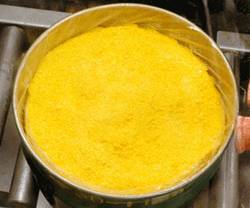
From Wikipedia, the free encyclopedia
This article is about the chemical urania. For the type of cake, see cake. For the falsified documents, see Yellowcake forgery.
| |
| Yellowcake | |
|---|---|
| Identifiers | |
| CAS number | 53125-22-7 |
| Properties | |
| Molecular formula | variable, see text |
| Appearance | Brown or black granules |
| Density | 9.055 g/cm3, solid |
| Melting point | 2878 °C |
| Boiling point | 4018 Kelvin |
[edit] Overview
The ore is first crushed to a fine powder by passing raw uranium ore through crushers and grinders to produce "pulped" ore. This is further processed with concentrated acid, alkaline, or peroxide solutions to leach out the uranium. Yellowcake is what remains after drying and filtering. The yellowcake produced by most modern mills is actually brown or black, not yellow; the name comes from the color and texture of the concentrates produced by early mining operations.Initially, the compounds formed in yellowcakes were not identified; in 1970, the U.S. Bureau of Mines still referred to yellowcakes as the final precipitate formed in the milling process and considered it to be ammonium diuranate or sodium diuranate. The compositions were variable and depended upon the leachant and subsequent precipitating conditions. Among the compounds identified in yellowcakes include: uranyl hydroxide, uranyl sulfate, sodium para-uranate, and uranyl peroxide, along with various uranium oxides. Modern yellowcake typically contains 70 to 90 percent triuranium octoxide (U3O8) by weight. Other oxides such as uranium dioxide (UO2) and uranium trioxide (UO3) exist.[2]
Yellowcake is used in the preparation of uranium fuel for nuclear reactors, for which it is smelted into purified UO2 for use in fuel rods for pressurized heavy-water reactors and other systems that use natural unenriched uranium.
Purified uranium metal (not the uranium oxide) can also be enriched in the isotope U-235. In this process, the uranium is combined with fluorine to form uranium hexafluoride gas (UF6). Next, that undergoes isotope separation through the process of gaseous diffusion, or in a gas centrifuge. This can produce low-enriched uranium containing up to 20 percent U-235 that is suitable for use in most large civilian electric-power reactors (some nuclear power reactor designs such as CANDU heavy water reactors use natural uranium oxides with <1% U-235 as fuel). With further processing one obtains highly enriched uranium, containing 20% or more U-235, that is suitable for use in compact nuclear reactors—usually used to power naval warships and submarines. Further processing can yield weapons-grade uranium with U-235 levels usually above 90%, suitable for nuclear weapons. However, since the collapse of the Soviet Union, there is a worldwide surplus of highly-enriched uranium, and Russian HEU is diluted to LEU for power reactors.
Yellowcake is produced by all countries in which uranium ore is mined.


No comments:
Post a Comment
Msomaji wetu hakikisha unaheshimu mila na tamaduni za mwafrika,lugha zenye utata au kumkashifu mtu haitapendeza kuonekana kwenye post.Kumbuka vigezo na masharti ya comments kuzingatiwa.Asanteni sana kwa kuwa nasi kwenye blog yenu.